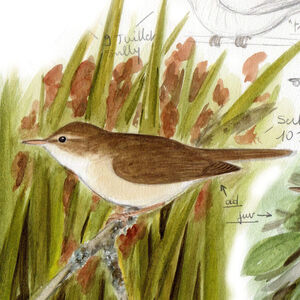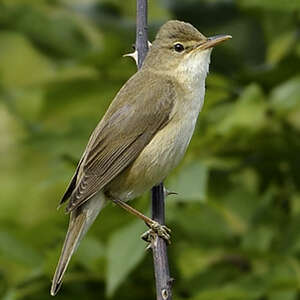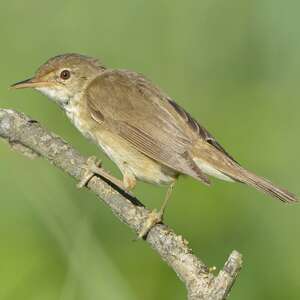Marsh Warbler
Acrocephalus palustris - Rousserolle verderolle
Identification
The Marsh Warbler is a close relative of the Common Grasshopper Warbler, which is very similar in appearance. The distinction between the two species is not always obvious and the best way to tell them apart is by their songs. Their habitats are also quite different. Compared to the Grasshopper Warbler, the Marsh Warbler is slightly larger and has paler, less 'warm' plumage without the red/brown tones that are present on the Grasshopper Warbler's body. Its underside is washed with pale fawn on its chest and sides, and its legs are a light pink-brown with pale claws. The bill is somewhat shorter and the forehead less prominent, resulting in a less 'pointy', less 'acrocephalic' appearance which is further emphasized when singing, with the crown feathers raised further.
Juveniles of both species look very similar and can only really be distinguished with some practice.
Subspecific information monotypic species
Foreign names
- Rousserolle verderolle,
- Carricero políglota,
- felosa-palustre,
- Sumpfrohrsänger,
- énekes nádiposzáta,
- Bosrietzanger,
- Cannaiola verdognola,
- kärrsångare,
- Myrsanger,
- trsteniarik obyčajný,
- rákosník zpěvný,
- Kærsanger,
- luhtakerttunen,
- Europese Rietsanger,
- boscarla menjamosquits,
- Seljusöngvari,
- łozówka,
- purva ķauķis,
- močvirska trstnica,
- Болотная камышевка,
- ヌマヨシキリ,
- 湿地苇莺,
- kärrsångare,
- 濕地葦鶯,
Voice song and call
Marsh Warbler most often sings while perched prominently on a tall grass or small bush. Its song is very different from that of the reed warbler. It is an entirely imitative potpourri, consisting of imitations of other birds, both European and African, mostly but not only passerines. This 100% imitative singing is both the Marsh Warbler's distinguishing feature and originality. Hence, it is the most original song amongst all of our singing passerines. It easily allows the Marsh Warbler to be distinguished from the reed warbler. It can start with the repetition of one note before evolving. The most frequent call, the one uttered upon entering the territory, is a sharp tenk from a warbler, repeated if necessary.
Habitat
The Marsh Warbler occupies high herbaceous vegetation dotted with bushes, growing near watercourses and the margins of ponds and marshes, and composed of tall helophytes.
Behaviour character trait
The Marsh Warbler leads a hidden life in the dense herbaceous vegetation it occupies, and if it wasn't for its vocal emissions, it would go unnoticed.
But once one knows it is present and it stays silent, its movements can be followed by seeing the movement of the stems. Indeed, it shares with the Grasshopper Warbler the same mode of movement in the herbaceous vegetation. It jumps or flies from one stem to another, grasping it laterally with its clawed feet, which causes the stems to swing. It hunts for the insects that are visible. The male sings while perched on a stem or bush, both to defend its territory and to attract a female. Once mated, it follows the female in her movements while singing, leaving her to do the nest building.When disturbed, for example when someone enters its territory, one can hear its tacs of worry that it repeats as long as the potential danger persists.
Flight
Dietfeeding habits
The Marsh Warbler is an insectivore. Its diet is broad and corresponds to the resources available at a given moment.
At the top come insects and their larvae. Floral Diptera such as hoverflies make up an important part of its breeding period diet. Caterpillars of butterflies or Tineidae are also sought. It knows how to take advantage of unexpected resources, for example during an aphid invasion or a caterpillar attack. Spiders are quite frequently captured. It happens for them to make small pellets to regurgitate items that are too big or indigestible. One can find shells of small gastropods, although it remains anecdotal.Reproduction nesting
The Marsh Warbler is a late migrant, given the distance of their wintering grounds. They don't return from Africa until May and even early June at high altitudes.
The male arrives first and sets out to find a territory on which he tries to attract a female by singing. Once the pair is formed, the female quickly creates a nest made of dry grass, much looser than the wren's nest, which she attaches to herbaceous stems at mid-height. The bowl-shaped nest is lined with rootlets and receives 4-5 blue-green spotted eggs, which are incubated by both partners for 10-14 days. Young leave the nest at 10-11 days of age. At this point, the family splits up, each parent taking care of part of the brood until they are emancipated.A first lost brood is replaced. Second clutches are rare but they exist in good years, when the environment allows it.
Post-nuptial depart is early and takes place as early as August. Only a minority of the population is still present in September. Indeed, the journey to their southern African wintering grounds is long and time-consuming.
Geographic range
The breeding range of the Marsh Warbler extends mainly, in longitude from Northwest France and South England to Russia, and in latitude from South Finland to the Balkans and the Caucasus with an extension to the mountainous areas of Northern Iran. In France, it can only be found north of a line from Normandy to North of the Alps.
It is an eastern type migrator whose migration routes pass through the East Mediterranean, the Middle East and East Africa. Its migration leads to the savannah areas of Southeast Africa, including the Cape region, where it winters.
Threats - protection
IUCN conservation status
concern
in the Wild
threatened
evaluated
The Marsh Warbler inhabits uncultivated areas alongside waterways, roads, ponds, and crop fields. It is very sensitive to any damage caused by humans such as mowing, herbicides dispersal, trampling, and outright destruction. A useful form of protection that concerns other species as well is the introduction of weedy uncultivated strips with late or occasional mowing as border areas around areas of human activity, especially farming.
Climate change is obviously having a negative impact on the Warbler's habitat. Reduced rain leads to less tall herbaceous vegetation, which is less suitable for nesting. At the same time, unfavourable woody vegetation invades the soils, which lose their hydromorphy.
Sources of information
- IOC World Bird List (v15.1), Gill, F and D Donsker (Eds). 2025-12-07.
- An Atlas of the Birds of the Western Palearctic, Colin Harrison
- Les passereaux d'Europe, tome 1, P. Géroudet, M. Cuisin
- Birds of the World, The Cornell Lab of Ornithology
- xeno-canto, Sharing bird sounds from around the world,
Other sources of interest
 Specification sheet created on
25/07/2023 by Jean François
Specification sheet created on
25/07/2023 by Jean FrançoisTranslation by AI Oiseaux.net
© 1996-2025 Oiseaux.net
- Accipitriformes
- Aegotheliformes
- Anseriformes
- Apodiformes
- Apterygiformes
- Bucerotiformes
- Caprimulgiformes
- Cariamiformes
- Casuariiformes
- Charadriiformes
- Ciconiiformes
- Coliiformes
- Columbiformes
- Coraciiformes
- Cuculiformes
- Eurypygiformes
- Falconiformes
- Galliformes
- Gaviiformes
- Gruiformes
- Leptosomiformes
- Mesitornithiformes
- Musophagiformes
- Nyctibiiformes
- Opisthocomiformes
- Otidiformes
- Passeriformes
- Pelecaniformes
- Phaethontiformes
- Phoenicopteriformes
- Piciformes
- Podargiformes
- Podicipediformes
- Procellariiformes
- Psittaciformes
- Pterocliformes
- Rheiformes
- Sphenisciformes
- Steatornithiformes
- Strigiformes
- Struthioniformes
- Suliformes
- Tinamiformes
- Trogoniformes


































